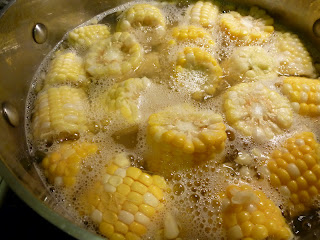You had to know this was coming. When I read the recipe in the August edition of Bon Appetit, I had to try it. Especially since Colorado sweet corn is making it's way to the farmer's markets. This is a week long process, but worth the effort. My waiting was over today, and I had my first taste. Wow, these juicy corn kernels were bursting with flavor. Lightly pickled with garlic flavor and a slight kick from the jalapeno, nothing too crazy or mouth burning. It's great that they'll keep for up to 3 weeks in the refrigerator.
Pickled Corn
Pickled Corn
Makes 12 servings
6 ears of corn, husked, cut crosswise into 1 1/2" rounds
5 1/2 Tb kosher salt plus more
10 garlic cloves
2 red chiles, cut crosswise into thin rounds, seeded
1 tsp whole black peppercorns
Cook corn in a large pot of lightly salted boiling water until crisp-tender, about 4 minutes. Using a slotted spoon, transfer to a bowl of ice water. Let cool, drain.
Layer corn, garlic, chiles, and peppercorns in a 4 qt glass or ceramic jar.
Stir 5 1/2 Tb salt and 2 quarts water in a large bowl until salt is dissolved, and pour over corn mixture. Make sure corn is submerged, weigh them down with plates if you need to. Cover jar with plastic wrap or a lid and let stand in a dark, cool place for 4 days to pickle. A room temperature of 68-70 is ideal. Taste the corn after 4 days, if you want more pucker, let it sit for another day or two. Then serve or refrigerate for up to 3 weeks.
Notes: I used green jalapenos instead. Knowing that we like things a little spicy I didn't even taste the corn at four days, I just let it continue to pickle for the week. That was perfect, I wouldn't change a thing.




















































